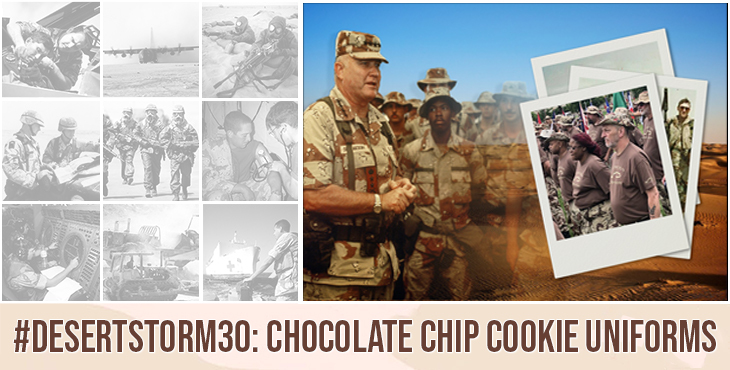Though it was first designed in 1962, finalized in 1976, and then standardized in 1990, the Desert Battle Dress Uniform (DBDU)—affectionately known for its “chocolate chip” or “cookie dough” camouflage patterns—defined the U.S. military era known for a single event: Operation Desert Storm.
That brief conflict and its decisive victory grabbed our nation’s attention 30 years ago this month. America watched the Persian Gulf War from thousands of miles away in nearly real time on a burgeoning 24-hour news cycle. It watched as reporters spoke from Baghdad rooftops, describing an eerily silent capitol in the minutes before Patriot and Scud missiles first lit up the night sky.
In the days that followed, what emerged from the televised destruction of Iraq were the endless loops of Army Generals Norman Schwarzkopf and Colin Powell, the smiling giants in battle dress towering over crowds of troops in the field. America watched its men and women on the front lines, in the chow halls, or standing victoriously in group photos, sometimes under Iraqi landmarks and Saddam Hussein murals. Etched into its collective mind, America’s chocolate chip became the sartorial symbol of its military might.
Though the DBDU is a variant of the Battle Dress Uniform (the BDU, with its three-color woodland pattern, lasted over 31 years in four different decades), its authorization for wear was short.
The 1992 version of AR 670-1 – Wear and Appearance of Army Uniforms and Insignia – spells out authorization for “year-round wear on duty by all personnel… when… prescribed by the commander.” And except for the Gulf War, only select units for select operations received authorization.
Functionally, the DBDU was also America’s first desert camouflage uniform. Designers at the U.S. Army Natick Soldier Research, Development & Engineering Center based its six-color (and later three-color) pattern on the rocky and elevated climate of the American South West. The front face of its 50/50 cotton-and-nylon twill made soiling and stains less noticeable; it measured well for infrared protection, and it was water resistant.
But the DBDU was also costly and more complex to produce, and later “deemed unsuitable for most desert theaters.” Its replacement – the Desert Camouflage Uniform (DCU) – began development in the 1980s and saw widespread use as early as 1992.
Today, it’s hard to see the DBDU outside the context of its time. It was so symbolic for its age that you could buy Bootleg Bart Simpson apparel and Topps baseball cards appropriating the pattern – not as themed accoutrement, but as defining feature. And, depending on your view, that it became a cultural pop icon either relegates it to – or enshrines it to – its brief moment under the sun.
For this writer (and Operation Iraqi Freedom Army Veteran), it’s so 1990s that it’s also rad. But we want to hear your thoughts, too. What are your memories of the DBDU? Sound off in the comments below!
CLICK HERE TO READ THE ARMY REGULATION ON THE UNIFORM
Graphic artist:
Topics in this story
More Stories
Summer Sports Clinic is a rehabilitative and educational sporting event for eligible Veterans with a range of disabilities.
Report examines the input of over 7,000 women Veterans: They are happier with VA health care than ever before.
Veterans and caregivers, you can help shape the future eligibility requirements for the VA Caregiver Support program.







Funny you mention the Chocolate Chip Desert Uniform. Deployed from Europe in woodland pattern BDU’s and did not receive our DBDU uniforms & boots until 3 days prior to departure from theater due to logistical blunder. Apparently our Division’s Conex’s were lost in the desert somewhere, we could not get our armored vehicles painted either as they “ran out” of the desert paint when our vehicles came off the ships early Dec 90′. It did not take long for the vehicles, uniforms and black boots to appear like the desert due to the sand & dust. We also transferred our OD green patches to the DBDU’s. When we climbed off the busses at Warner Barracks (Bamberg, GE) we looked like brand new soldiers after 6 months in the desert, tanned, skinny, fresh haircuts and brand new uniforms. Still have mine in a footlocker. Thankful to return to my family and proud to serve. Iron Soldiers!!
It was kind of a status symbol camo in the military for a while. I still have one pair of cammies, the boonie hat, helmet cover, and pack cover.
Most of us that wore them remember them fondly… I can’t speak for everyone, but for my unit… nobody had anything but US ARMY name tapes in OD GREEN… all of our patches… everything was still green… my old DS chocolate chip uniform that I have hanging in my closet still has nothing but OD Green patches all over it… In a way… that uniform.. with green name tapes and unit patches, tabs, etc.. is truly a transitionally historical uniform… it marks the transition of the US military from OD green to Desert tan and all of the variants since… I found an old DS cap online last month… I was never issued one of those… we always had to wear our damn K-Pots all day and all night…. no boonie hats for us until we got back to the States! Anyway… I saw that chocolate chip patrol cap and said to myself… I don’t remember even seeing that style cap… I gotta have that! Bought it… got it in the mail a few days later… decided to put my Ranger tab on the front of it… which type? OD Green Ranger tab or Desert tan? I stayed true to what I knew…. got the sewing lady to sew on one of my old OD Green Ranger tabs on the front of that DS chocolate chip patrol cap… if I do say so myself…. it looks kinda old school cool… kinda like the grandpa that wears it….
STILL THANKING JESUS CHRIST FOR HIS CONTINUOUS BLESSINGS AND KEEPING MY HUSBAND SAFE THROUGH DESERT STORM, DESERT SHIELD, AND NOW. HE ALSO RECEIVED A BRONZE STAR FOR HIS COURAGEOUS ACTIONS. GO HUBBY!!